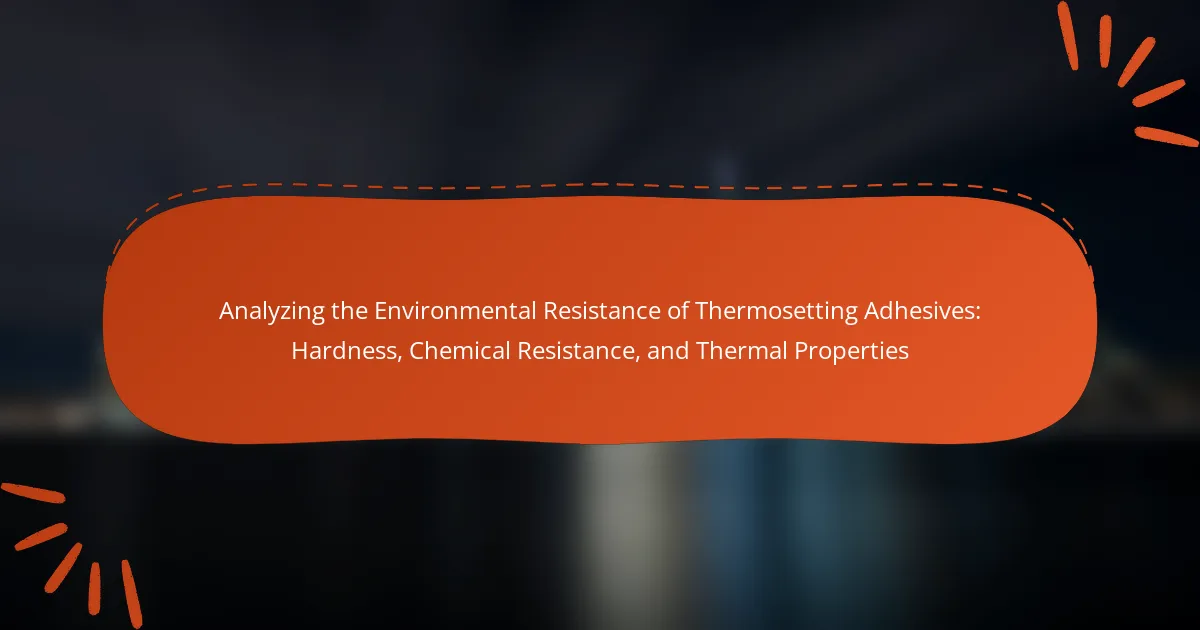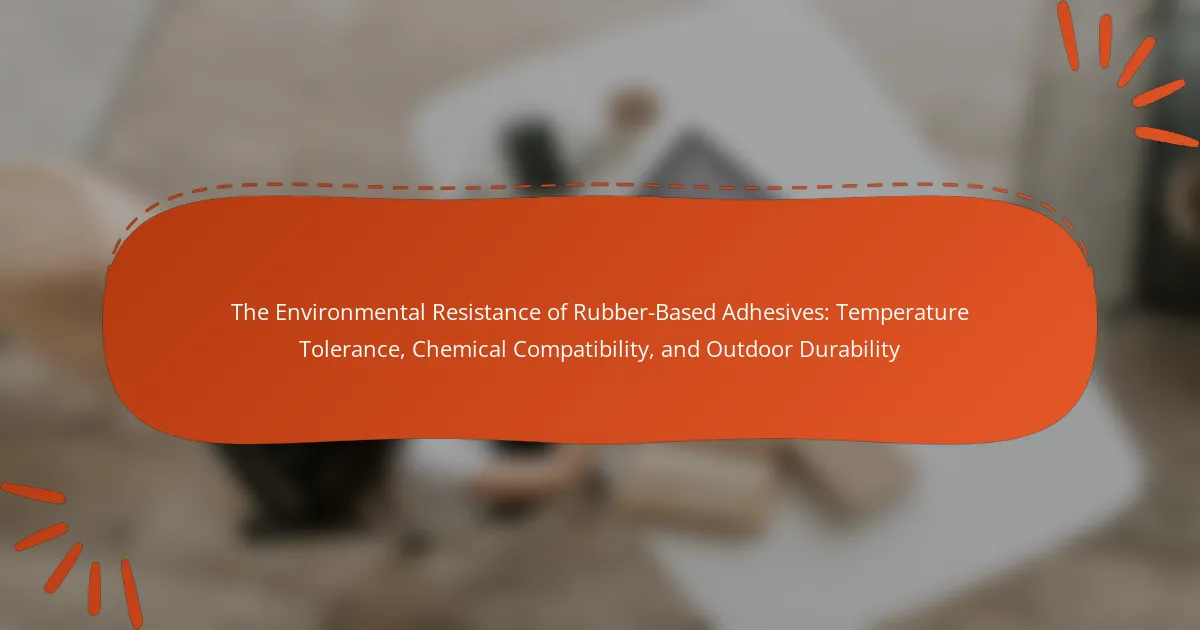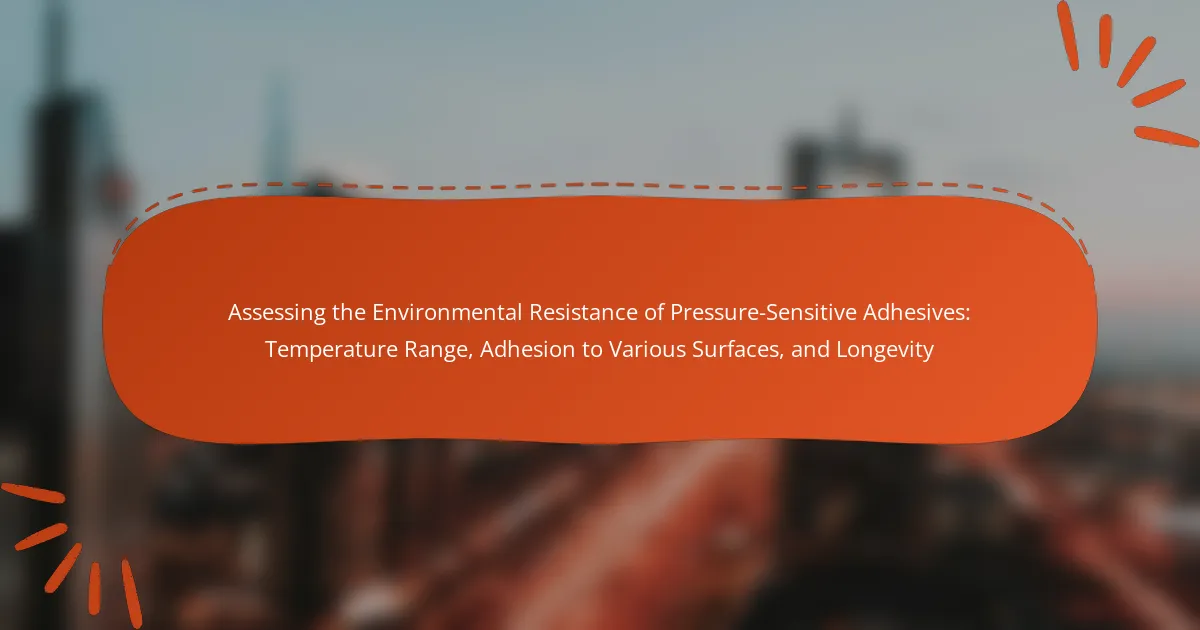Thermosetting adhesives are specialized adhesives that undergo a chemical transformation upon curing, resulting in a strong and heat-resistant bond. This article analyzes the environmental resistance of thermosetting adhesives, focusing on their hardness, chemical resistance, and thermal properties. Key aspects include the measurement of hardness using Shore hardness tests, the significance of thermal stability and glass transition temperature, and the implications of these properties for applications in industries such as automotive, aerospace, and construction. The discussion emphasizes how these adhesives maintain structural integrity under extreme conditions, ensuring reliability and performance in demanding environments.

What are Thermosetting Adhesives and Their Importance?
Thermosetting adhesives are a type of adhesive that undergoes a chemical change when cured, resulting in a rigid and heat-resistant bond. They are formed through a process called polymerization, where the adhesive hardens irreversibly upon heating. This characteristic makes them suitable for applications requiring strong and durable bonds. Thermosetting adhesives exhibit excellent resistance to heat, chemicals, and environmental factors. Their importance lies in their ability to provide long-lasting adhesion in demanding conditions. Industries such as automotive, aerospace, and construction utilize thermosetting adhesives for their reliability and performance. Studies show that thermosetting adhesives maintain structural integrity under extreme temperatures and harsh chemicals, enhancing product longevity and safety.
How do Thermosetting Adhesives differ from Thermoplastics?
Thermosetting adhesives and thermoplastics differ primarily in their chemical structure and behavior under heat. Thermosetting adhesives cure permanently when heated, creating a rigid structure that cannot be remelted. In contrast, thermoplastics soften when heated and can be reshaped multiple times. This difference affects their applications; thermosetting adhesives are ideal for high-temperature environments due to their stability. Thermoplastics, however, are often used where flexibility and reusability are desired. The curing process of thermosetting adhesives involves cross-linking, which enhances their hardness and chemical resistance. Thermoplastics lack this cross-linking, making them less durable in extreme conditions.
What are the key characteristics of Thermosetting Adhesives?
Thermosetting adhesives are characterized by their permanent bond formation upon curing. They undergo a chemical change that makes them inflexible and heat-resistant. These adhesives are known for high thermal stability, often maintaining integrity at elevated temperatures. They exhibit excellent chemical resistance, making them suitable for harsh environments. Their hardness increases after curing, providing structural strength. Thermosetting adhesives also offer low moisture absorption, enhancing durability. They are typically used in applications requiring long-term performance and reliability. Common types include epoxy, phenolic, and polyurethane adhesives.
Why are Thermosetting Adhesives preferred in certain applications?
Thermosetting adhesives are preferred in certain applications due to their superior strength and durability. These adhesives undergo a chemical change when cured, creating a rigid structure that withstands high temperatures. They exhibit excellent resistance to chemicals, making them suitable for harsh environments. Their thermal stability ensures that bonded joints maintain integrity under extreme conditions. Additionally, thermosetting adhesives provide strong adhesion to various substrates, including metals and plastics. Their long-term performance is often more reliable compared to thermoplastics. Industries like automotive and aerospace favor these adhesives for critical bonding applications. Overall, their unique properties make them ideal for demanding applications requiring durability and resistance.
What are the primary environmental resistances of Thermosetting Adhesives?
Thermosetting adhesives exhibit primary environmental resistances such as heat, moisture, and chemical exposure. They are designed to withstand high temperatures without losing their structural integrity. This heat resistance allows them to be used in applications requiring durability under thermal stress. Additionally, thermosetting adhesives resist moisture, preventing degradation in humid environments. Their chemical resistance protects against solvents and acids, making them suitable for various industrial applications. These resistances contribute to their longevity and reliability in demanding conditions.
How does hardness impact the performance of Thermosetting Adhesives?
Hardness significantly impacts the performance of thermosetting adhesives. Increased hardness typically enhances the adhesive’s strength and durability. Harder adhesives can better withstand mechanical stress and environmental factors. This quality is crucial for applications requiring high load-bearing capacity. For instance, thermosetting adhesives with higher hardness values exhibit improved shear strength. Research indicates that the hardness of epoxy adhesives correlates with their resistance to deformation under load. In practical terms, this means that harder adhesives maintain their integrity in demanding conditions. Therefore, selecting the appropriate hardness level is essential for optimal adhesive performance.
What role does chemical resistance play in the durability of Thermosetting Adhesives?
Chemical resistance is crucial for the durability of thermosetting adhesives. It prevents degradation when exposed to harsh chemicals. This resistance ensures that the adhesive maintains its bond strength over time. Thermosetting adhesives undergo a curing process that enhances their chemical stability. As a result, they can withstand solvents, acids, and bases without losing integrity. Studies show that adhesives with high chemical resistance last significantly longer in challenging environments. For instance, epoxy-based thermosetting adhesives are known for their superior resistance to various chemicals. This property makes them ideal for industrial applications where exposure to corrosive substances is common.
How do thermal properties influence the application of Thermosetting Adhesives?
Thermal properties significantly influence the application of thermosetting adhesives. These adhesives undergo irreversible curing when exposed to heat, which enhances their structural integrity. The heat resistance of thermosetting adhesives allows them to maintain performance in high-temperature environments. This property is critical in applications like automotive and aerospace industries, where thermal stability is essential. Additionally, thermal properties affect the curing process, determining the adhesive’s final hardness and strength. For example, higher curing temperatures can lead to improved mechanical properties. The ability to withstand thermal cycling without degradation is also vital for long-term performance. Thus, understanding thermal properties is crucial for selecting the appropriate thermosetting adhesive for specific applications.

How is the Hardness of Thermosetting Adhesives Measured?
The hardness of thermosetting adhesives is measured using standardized testing methods such as the Shore hardness test. This test involves pressing a durometer into the adhesive surface to determine its resistance to indentation. The Shore A scale is commonly used for softer materials, while the Shore D scale is applied for harder materials. The resulting hardness value indicates the material’s stiffness and durability. Accurate measurements are crucial for assessing the adhesive’s performance in various applications. These methods are widely recognized in industry standards, ensuring consistency and reliability in results.
What tests are used to determine the hardness of Thermosetting Adhesives?
The primary tests used to determine the hardness of thermosetting adhesives are the Shore hardness test and the Rockwell hardness test. The Shore hardness test measures the resistance of the adhesive to indentation. It uses a durometer to assess the hardness on a scale from 0 to 100. The Rockwell hardness test evaluates the depth of [censured] of an indenter under a large load compared to the [censured] made by a preload. This test provides a numerical value indicating hardness. Both tests are widely accepted in the industry for assessing adhesive hardness. They help in determining the suitability of adhesives for specific applications.
What are the implications of hardness measurements on adhesive performance?
Hardness measurements significantly impact adhesive performance. Higher hardness often correlates with better mechanical strength and resistance to deformation. This means adhesives with higher hardness can withstand greater loads without failing. Conversely, lower hardness may indicate increased flexibility, which can be beneficial in applications requiring movement or vibration absorption.
Research shows that the hardness of adhesives can influence their bonding capacity. For instance, a study published in the Journal of Adhesion Science and Technology found that harder adhesives typically exhibit improved shear strength. Additionally, hardness affects the adhesive’s resistance to environmental factors, such as temperature and humidity.
In summary, measuring hardness provides insights into an adhesive’s mechanical properties and durability under various conditions.
How does hardness vary among different types of Thermosetting Adhesives?
Hardness varies significantly among different types of thermosetting adhesives. Epoxy adhesives typically exhibit high hardness due to their cross-linked structure. This makes them suitable for applications requiring strong bonds and durability. Phenolic adhesives also demonstrate high hardness, often used in high-temperature environments. Polyurethane adhesives, however, tend to be softer and more flexible, providing better impact resistance. The hardness of these adhesives can be measured using the Shore hardness scale. For instance, epoxy adhesives can achieve Shore D hardness values ranging from 80 to 90. In contrast, polyurethane adhesives may range from 60 to 80 on the same scale. This variation in hardness affects their performance in different applications, influencing factors like load-bearing capacity and environmental resistance.
Why is Chemical Resistance Critical for Thermosetting Adhesives?
Chemical resistance is critical for thermosetting adhesives because it ensures durability and performance in harsh environments. Thermosetting adhesives undergo a chemical reaction during curing, forming a strong, cross-linked structure. This structure must withstand exposure to solvents, acids, and bases without degrading. Failure to resist chemicals can lead to bond failure, compromising the integrity of the materials being joined. For instance, certain industries, such as automotive and aerospace, require adhesives to endure exposure to fuels and lubricants. Studies show that thermosetting adhesives with high chemical resistance maintain their mechanical properties even after prolonged exposure to aggressive substances. This characteristic is essential for applications where safety and reliability are paramount.
What factors affect the chemical resistance of Thermosetting Adhesives?
The chemical resistance of thermosetting adhesives is affected by several factors. These include the chemical composition of the adhesive, which determines its molecular structure. The cross-linking density also plays a crucial role; higher density typically enhances resistance. Temperature and environmental conditions can alter the adhesive’s performance over time. The presence of fillers and additives can modify the adhesive’s properties, impacting resistance. Additionally, the type of solvent or chemical exposure influences the degradation process. Testing methods, such as immersion tests, provide empirical evidence of chemical resistance levels.
How can chemical exposure impact the longevity of Thermosetting Adhesives?
Chemical exposure can significantly reduce the longevity of thermosetting adhesives. These adhesives are designed to withstand high temperatures and harsh environments. However, exposure to certain chemicals can lead to degradation. Chemical agents can cause hydrolysis, which weakens the adhesive bond. They may also lead to swelling or embrittlement of the adhesive material. Studies show that solvents and acids can accelerate these degradation processes. For example, exposure to water or alkaline substances can shorten the lifespan of these adhesives. Therefore, understanding the chemical environment is crucial for predicting adhesive performance.

What Thermal Properties are Essential for Thermosetting Adhesives?
Thermal properties essential for thermosetting adhesives include thermal stability, glass transition temperature, and thermal conductivity. Thermal stability ensures that the adhesive maintains its performance under high temperatures. Glass transition temperature indicates the temperature range where the adhesive transitions from a hard, glassy state to a softer, more pliable state. This property is crucial for maintaining bond integrity in varying environmental conditions. Thermal conductivity affects how heat is transferred through the adhesive, influencing its suitability for applications involving temperature fluctuations. High thermal stability and appropriate glass transition temperature are vital for applications in automotive and aerospace industries, where adhesives face extreme conditions.
How do thermal properties affect the usability of Thermosetting Adhesives?
Thermal properties significantly influence the usability of thermosetting adhesives. These adhesives undergo a curing process that is sensitive to temperature. High thermal stability allows them to maintain bond integrity under heat exposure. Conversely, inadequate thermal resistance can lead to bond degradation. For instance, thermosetting adhesives often have glass transition temperatures (Tg) above their operating temperatures. This ensures they retain their mechanical properties in various applications. Additionally, thermal conductivity affects the adhesive’s ability to transfer heat, impacting performance in thermal management applications. Overall, the thermal properties dictate the operational limits and performance reliability of thermosetting adhesives in different environments.
What are the thermal stability limits for various Thermosetting Adhesives?
Thermal stability limits for various thermosetting adhesives typically range from 150°C to 300°C. Epoxy adhesives generally withstand temperatures up to 250°C. Phenolic adhesives can endure temperatures as high as 300°C. Polyurethane adhesives usually have stability limits around 120°C to 180°C. Silicone adhesives are known for their high thermal resistance, often exceeding 200°C. These limits are influenced by the chemical structure and formulation of the adhesive. Testing methods like thermogravimetric analysis confirm these stability ranges.
How does thermal cycling influence the performance of Thermosetting Adhesives?
Thermal cycling significantly impacts the performance of thermosetting adhesives. It causes expansion and contraction within the adhesive matrix. This mechanical stress can lead to micro-cracking. Micro-cracking reduces the adhesive’s bond strength. Studies show that repeated thermal cycling can decrease adhesion durability. For instance, research indicates that adhesive performance can drop by up to 30% after extensive thermal cycling. The thermal stability of the adhesive formulation also plays a crucial role. Adhesives with higher thermal resistance generally withstand thermal cycling better.
What are the best practices for selecting Thermosetting Adhesives based on environmental resistance?
Select thermosetting adhesives by evaluating their environmental resistance through specific criteria. First, consider the adhesive’s chemical resistance to solvents and acids. This ensures durability in harsh environments. Next, assess thermal stability, which indicates performance under temperature fluctuations. Review the adhesive’s moisture resistance to prevent degradation in humid conditions. Analyze the manufacturer’s data sheets for specific environmental resistance ratings. Finally, conduct real-world testing to validate performance claims. This approach leads to informed selection and optimal adhesive performance.
How can users ensure optimal performance of Thermosetting Adhesives in specific applications?
Users can ensure optimal performance of thermosetting adhesives by selecting the appropriate formulation for specific applications. The choice of adhesive should align with the materials being bonded and the environmental conditions they will face. Proper surface preparation is crucial; surfaces must be clean, dry, and free from contaminants. Users should follow the manufacturer’s recommended curing conditions, as temperature and time significantly affect bond strength. Additionally, applying the adhesive within the specified pot life ensures effective bonding. Testing the adhesive under actual application conditions can validate its performance. Research indicates that proper adhesion and curing can enhance chemical and thermal resistance, making the adhesive suitable for demanding environments.
What common troubleshooting tips exist for issues related to Thermosetting Adhesives?
Common troubleshooting tips for issues related to thermosetting adhesives include ensuring proper mixing of components. Incorrect ratios can lead to inadequate curing. Check the ambient temperature; it should align with the adhesive’s specifications for optimal performance. Inspect the surfaces to ensure they are clean and free of contaminants. Contaminated surfaces can hinder adhesion. Verify the curing time; insufficient time can result in weak bonds. If issues persist, consider the adhesive’s compatibility with the materials being bonded. Lastly, evaluate storage conditions; improper storage can affect adhesive properties.
Thermosetting adhesives are specialized adhesives that form rigid, heat-resistant bonds through a permanent chemical change during curing. This article analyzes their environmental resistance, focusing on key attributes such as hardness, chemical resistance, and thermal properties. It explores how these characteristics impact the performance and durability of thermosetting adhesives in demanding applications across various industries, including automotive and aerospace. Additionally, the article discusses the differences between thermosetting adhesives and thermoplastics, the significance of hardness measurements, and best practices for selecting and using these adhesives effectively.



